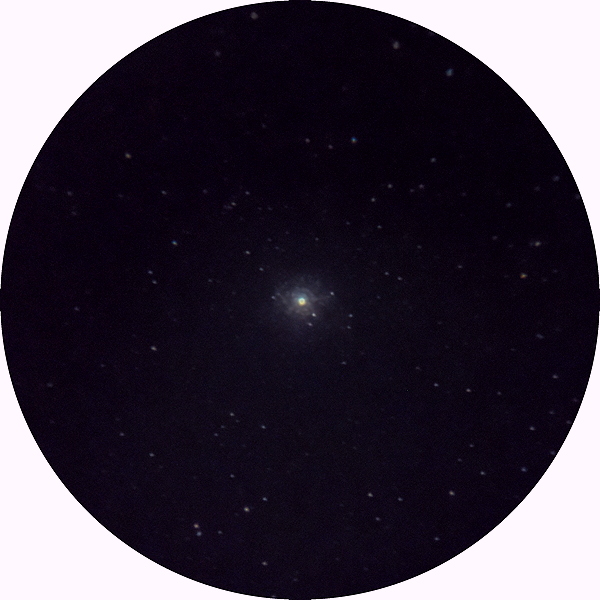Weather, Talks,
iPhone Globular Clusters, DSLR NGC6951 Galaxy
Posted: 30 August 2022
Cloudy skies continued since my last observing session on 3 August 2022. Wednesday evening, 17 August, had a thunderstorm (0.32").
Our Internet connection modem failed Wednesday night, 17 August. It took two days for the replacement to arrive. During the outage, our weather stations and webcams were off the Internet. We used our iPhones and iPads as "hotspots" to provide Internet connectivity for our computers.
On Thursday, 18 August, I joined the Explore Alliance Live show to talk about several topics, including the David H. Levy Arizona Dark Sky Star Party & The Oracle Dark Sky Cultural Festival to be held in Oracle 21-25 September. Click the image below to view a recording of the show. I joined the show at 31:21.

Click image to view video recording
Late Thursday afternoon a brief rainshower (0.05") come through. After it passed there was a nice double rainbow in the blue sky and then an interesting sunset.


Thursday night, 18 August, was the 13th anniversary of "First Light" at Cassiopeia Observatory. In celebration here is a short video of the "Making of Cassiopeia Observatory".
Friday afternoon, 19 August, had a light rainshower (0.09"). Saturday, 20 August, shortly after sunrise had 0.6" rain in 20 minutes, which I reported to the National Weather Service office in Tucson. By late morning a total of 1.36" rain had fallen. One of the Kitt Peak National Observatory webcams came back online on Saturday using local generator power. It was good to see the mountain and some observatories again after the Contreras Fire in June 2022. Unfortunately, the webcam was online only a few days.
Monday, 22 August, began mostly clear, but clouds began appearing mid-day, becoming mostly overcast as sunset approached. Tuesday, 23 August, had a brief rainshower mid-afternoon (0.02") and a brief thunderstorm late afternoon (0.12"). Shortly after sunset there was some lightning in the western sky (webcam photo).

On Wednesday, 24 August, I joined an Explore Alliance Live show once again to talk about the David H. Levy Arizona Dark Sky Star Party & The Oracle Dark Sky Cultural Festival. Click the image below to view a recording of the show.

Click image to view video recording
Thursday morning, 25 August, both of the Kitt Peak National Observatory webcams were online. Had a very brief rainshower here (0.01"). Friday, 26 August, had a rainshower mid-morning (0.15"). Saturday, 27 August, was mostly clear during the day as our Monsoon weather pattern was finally taking a break, but clouded up after sunset. Sunday, 28 August, dawned clear, had clouds forming mid-morning, and was mostly cloudy at sunset. Monday, 29 August, dawned clear and stayed mostly clear.
|
Open: Monday, 29 August 2022, 1810 MST Temperature: 85°F |
Session: 1784 Conditions: Mostly clear |
Equipment:
12" f/8 LX600 w/StarLock
2" 24mm UWA eyepiece
1.25" 15mm eyepiece
Camera:
iPhone 13 Pro Max
D850 DSLR
1820 MST: Dome Cover OFF.
SYNCed observatory clock to WWV time signal.
1832-1850 MST: Relaxed on observatory patio bench.

1851 MST: LX600 ON, StarLock OFF, High Precision OFF.
1852 MST: Sunset.
Viewed the Moon, 102X.
Prepared the D850 DSLR for imaging later in the session.
1915 MST: Saw the planet Mercury, naked eye. Viewed Mercury, 102X.
1923 MST: Took this handheld iPhone 13 Pro Max photo of the Moon, afocal 102X, using NightCap Camera (ISO 200, 1/300sec, 1X lens).

1931-1950 MST: Relaxed on the bench.
1952 MST: High Precision ON.
Viewed M9 (globular cluster), 102X and 163X.
Attached my LiDAR Cover on the iPhone and mounted the iPhone on the 15mm eyepiece using the Levenhuk adapter. After a nearly four-week absence from the observatory due to Monsoon Season cloudy nights, I planned to image many Messier Catalog globular clusters, afocal 163X, StarLock autoguided, using NightCap Camera (Long Exposure, Light Boost, ISO 32000 or ISO 16000, 1sec, 1 minute, 1X lens).
2002 MST: StarLock ON.
M9

M19

M62

M80

M107

M14

M28

M54

M69

M70

2102 MST: StarLock OFF.
Most of the globular clusters were low in the southern sky where there were some thin clouds. Seeing was not good and autoguiding was erratic at times.
Viewed M70 (globular cluster), 163X and 102X.
Viewed NGC5982 (galaxy), 102X. I had been planning to image the trio of galaxies NGC5981/5982/5985 this summer but cloudy nights foiled that plan. I had hoped to image the trio this night but it was getting into trees to the northwest of the observatory.
Viewed NGC6951 (galaxy), 102X.
Mounted the D850 DSLR at prime focus, focused on the star Shedir, and locked the 12" primary mirror.
2139 MST: StarLock ON.
Did two framing test images of NGC6951. Took this StarLock autoguided, ISO 6400, 5 minutes, White Balance 5000K, image of NGC6951 (galaxy), slightly cropped.

2156 MST: StarLock OFF, High Precision OFF.
Viewed the planets Saturn and then Jupiter, 102X.
2207 MST: LX600 OFF.
2218 MST: Took a Sky Quality reading using the Unihedron SQM-L meter.
|
Close: Monday, 29 August 2022, 2221 MST Temperature: 77°F |
Session Length: 4h 11m Conditions: Mostly clear, breezy, SQM 20.93 |
Comments are welcome using Email. Twitter users can use the button below to tweet this report to their followers. Thanks.
Cassiopeia Observatory Home Page
Copyright ©2022 Michael L. Weasner / mweasner@mac.com. Email Etiquette.
URL = http://www.weasner.com/co/Reports/2022/08/30/index.html
